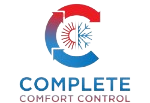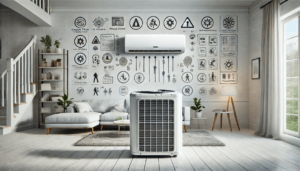Introduction
In Ontario, where the climate fluctuates dramatically between hot, humid summers and freezing winters, HVAC systems play a crucial role in maintaining indoor comfort throughout the year. Whether it’s the bitter cold of January or the sweltering heat of July, a reliable top HVAC services in Ontario ensures that homes remain comfortable and safe no matter the weather outside. However, just like any other major system in your home, HVAC systems require regular maintenance to function efficiently. Without proper care, you risk not only losing comfort but also facing higher energy bills and unexpected repair costs.
Regular HVAC maintenance is essential for preserving the longevity and performance of your system. By keeping everything running smoothly, you can prevent small issues from escalating into expensive repairs, improve your home’s energy efficiency, and ensure consistent indoor air quality. A well-maintained system uses less energy, lasts longer, and provides optimal heating and cooling for every season.
In this guide, we will cover everything you need to know about HVAC services in Ontario, including the most common heating and cooling systems, the importance of maintenance, and how to choose the right service provider. Whether you’re considering upgrading your current system or want to learn more about how to keep your HVAC unit in top shape, this blog will provide valuable insights for every homeowner.

Understanding HVAC Systems
HVAC stands for Heating, Ventilation, and Air Conditioning. It is an essential technology that regulates the indoor climate of residential, commercial, and industrial spaces. HVAC systems are designed to maintain comfort levels by controlling the temperature, humidity, and air quality within a building. Whether you’re battling the harsh cold of Ontario winters or the sweltering heat of summer, HVAC systems are vital to ensuring a comfortable indoor environment.
Explain What HVAC Stands For: Heating, Ventilation, and Air Conditioning
Heating: The heating component of an HVAC system is designed to generate warmth within the building during colder months. In Ontario, where temperatures can dip below freezing, heating systems are a critical aspect of any home or business. Proper heating ensures that inhabitants stay warm and safe from potential cold-related health issues such as hypothermia and frostbite. The most common types of heating systems in Ontario include furnaces, heat pumps, and boilers.
Ventilation: Ventilation is the process of exchanging indoor air with fresh outdoor air, ensuring that indoor air remains free from pollutants, moisture, and odours. Ventilation systems help remove airborne contaminants such as dust, allergens, and bacteria, improving indoor air quality. In regions like Ontario, where homes are sealed tightly to preserve heat during winter, proper ventilation is critical for maintaining healthy air.
Air Conditioning: Air conditioning (AC) is essential for cooling indoor spaces during hot weather. Air conditioners work by removing heat and humidity from the indoor air, replacing it with cooler air. Given the summer heatwaves in Ontario, having an efficient air conditioning system is vital for maintaining comfort during the warmer months. Common AC systems include central air conditioning, ductless mini-splits, and window or portable air conditioners.
Overview of How HVAC Systems Work to Regulate Indoor Temperature and Air Quality
HVAC systems function by combining three essential processes: heating, cooling, and ventilation.
- Heating Process: During the winter months, the heating component of the system kicks in. Furnaces, boilers, and heat pumps are used to generate heat. A thermostat detects when the indoor temperature falls below a certain threshold, signalling the HVAC system to activate the heating component. The heat is then distributed through ducts (in forced-air systems) or radiators (in water-based systems) to maintain the desired indoor temperature.
- Cooling Process: When cooling is required, the air conditioning system draws warm air from inside the building, extracts the heat through a refrigeration cycle, and then blows cooled air back into the space. The thermostat is again responsible for regulating when the cooling system should turn on and off, depending on indoor temperature settings.
- Ventilation Process: Ventilation works continuously, ensuring that air inside the building remains fresh and clean. In forced-air HVAC systems, air is circulated through ducts, where it passes through filters that trap dust, allergens, and other particles. Fresh air is drawn in from the outside, while stale or polluted air is vented out, maintaining a healthy indoor environment.
Importance of Choosing the Right System for Your Home or Business
Selecting the appropriate HVAC system for your home or business is crucial for energy efficiency, comfort, and long-term savings. In Ontario, where the climate ranges from extremely cold winters to hot, humid summers, it’s essential to invest in a system that can handle temperature fluctuations. Choosing the wrong system can result in higher energy bills, poor indoor air quality, and reduced comfort levels.
For example, a furnace might be the best choice for a large home that requires powerful heating during Ontario winters, while a heat pump may be a better option for a smaller home looking to maximize energy efficiency year-round. Additionally, modern HVAC systems come with advanced features like smart thermostats and zoning systems, which allow you to control the temperature in specific areas of your home or business, further increasing energy savings.
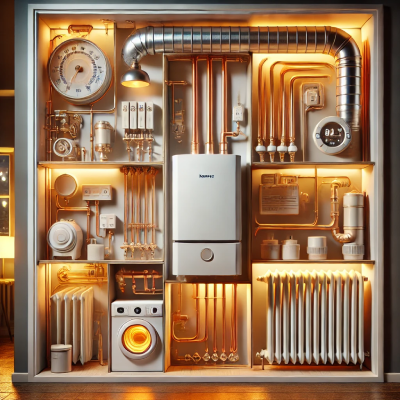
Heating Systems
In Ontario, where winter temperatures can reach extreme lows, having a reliable and efficient heating system is non-negotiable. The type of heating system you choose will greatly impact your comfort, energy bills, and environmental footprint.
Types of Heating Systems Commonly Used in Ontario:
- Furnaces: Furnaces are one of the most common heating systems in Ontario and across Canada. They work by heating air and distributing it throughout a building via a network of ducts. There are three main types of furnaces:
- Gas Furnaces: The most popular type due to the relatively low cost of natural gas in Ontario. Gas furnaces are energy-efficient and provide quick, powerful heat during the cold months. They are ideal for larger homes that require consistent warmth.
- Electric Furnaces: While less common than gas furnaces, electric furnaces are a viable option for homes without access to natural gas. Electric furnaces convert electrical energy into heat, making them a clean energy option, though they tend to be more expensive to operate.
- Oil Furnaces: Once widely used, oil furnaces are now less common in Ontario due to the rise of natural gas. However, they are still found in rural areas where natural gas lines are not available. While oil furnaces provide strong heating, they are less energy-efficient and more expensive to maintain compared to gas furnaces.
- Heat Pumps: Heat pumps are gaining popularity in Ontario due to their energy efficiency and ability to both heat and cool homes. A heat pump works by transferring heat from one place to another, depending on the season. In winter, it extracts heat from the outside air and moves it indoors; in summer, it does the opposite, acting as an air conditioner.
- Benefits: Heat pumps are highly efficient, particularly in milder winter conditions. They are ideal for homeowners looking to reduce their carbon footprint and energy costs.
- When They Are Most Effective: Heat pumps are most effective in areas with moderate winters. In Ontario, newer cold-climate heat pumps can handle colder temperatures, but they may require supplementary heating in extremely cold weather.
- Boilers: Boilers are used in hydronic heating systems, where water is heated and circulated through pipes to radiators or underfloor heating systems. While less common than forced-air systems, boilers provide efficient, even heating and are especially useful in homes with radiant floor heating.
- How They Work: Boilers use either gas, oil, or electricity to heat water, which is then circulated through the home to provide warmth. The heat is distributed through radiators, baseboard heaters, or radiant floor systems.
- Where They Are Used: Boilers are more commonly found in older homes or in regions where hydronic heating systems are preferred. They are also popular in multi-story buildings, as the heat from radiators can rise naturally through the structure.
- Radiant Heating: Radiant heating involves installing heated elements, such as electric mats or water pipes, under the floor. This type of heating system is energy-efficient and provides a consistent, even warmth throughout the space.
- Underfloor Heating Solutions: Radiant heating can be installed under tile, wood, or laminate flooring, providing a discreet and comfortable heating solution. It’s particularly popular in bathrooms and kitchens, where cold floors can be uncomfortable during the winter.
- Energy Efficiency: Radiant heating is highly efficient since it directly heats objects and people in the room, rather than heating the air. It’s an excellent option for reducing energy costs and increasing comfort in your home.

Energy Efficiency and Cost-Effectiveness of Different Heating Systems
When choosing a heating system, it’s essential to consider energy efficiency and cost-effectiveness. Gas furnaces, for example, tend to be more affordable in terms of fuel costs but may have higher installation expenses. Heat pumps, on the other hand, offer excellent energy savings over time but may be less effective in extremely cold weather without backup heating. Boilers provide even heating but can have higher upfront installation costs.
In Ontario, the Ontario Energy Board offers various incentives and rebates for homeowners who install energy-efficient heating systems, making it more affordable to switch to eco-friendly options.
Cooling Systems
As summer temperatures in Ontario continue to rise, having a reliable and efficient cooling system is essential for staying comfortable. There are several types of cooling systems available, each with its own advantages and considerations.
Types of Cooling Systems Available:
- Central Air Conditioners: Central air conditioners are the most common type of cooling system in larger homes. They work by distributing cooled air through a network of ducts, similar to how forced-air heating systems operate. Central AC systems are highly efficient at cooling large spaces quickly and evenly.
- When to Use: Central air conditioners are ideal for homes with existing ductwork, as they can be integrated into the same system used for heating. They are best suited for homes with multiple rooms that require consistent cooling.
- Ductless Mini-Splits: Ductless mini-splits are energy-efficient cooling systems that don’t require ductwork. These systems consist of an outdoor unit connected to one or more indoor units, which can be installed in different rooms or zones.
- Benefits: Ductless mini-splits are perfect for homes without existing ductwork or for cooling specific rooms or areas. They are also more energy-efficient than central air systems since they allow for temperature control in individual zones, reducing energy waste.
- Energy Efficiency: Mini-splits are known for their high energy efficiency, with some models achieving SEER (Seasonal Energy Efficiency Ratio) ratings of 20 or higher. They are an excellent option for homeowners looking to reduce energy consumption.
- Window AC Units: Window air conditioners are budget-friendly options for cooling small spaces or single rooms. These units are installed directly in a window, with the majority of the unit sitting outside the home.
- When to Use: Window AC units are best for apartments, small homes, or rooms that don’t require central air conditioning. While less energy-efficient than central systems, they provide an affordable cooling solution.
- Portable Air Conditioners: Portable air conditioners offer temporary or supplemental cooling in situations where permanent systems are not feasible. These units can be moved from room to room, providing flexibility and convenience.
- When to Use: Portable air conditioners are ideal for renters or for spaces where window or central AC installations are not possible. They are also a great option for emergency cooling or for rooms that are rarely used.
Importance of SEER Ratings and Energy Efficiency
SEER (Seasonal Energy Efficiency Ratio) ratings are a key factor in determining the energy efficiency of cooling systems. The higher the SEER rating, the more energy-efficient the system. In Ontario, where summers can be humid and hot, investing in a high-SEER air conditioning system can lead to significant savings on energy bills over time.
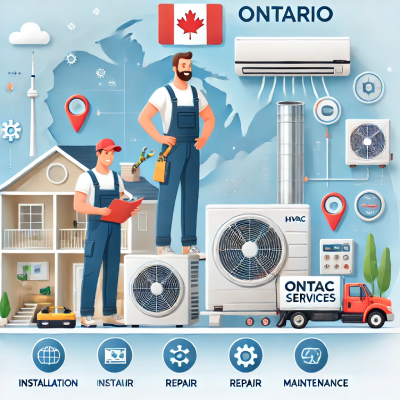
Top HVAC Services in Ontario
Ontario’s diverse climate, with harsh winters and warm summers, creates a consistent demand for high-quality HVAC services. Homeowners and businesses alike rely on HVAC systems to maintain comfortable indoor temperatures throughout the year. The province’s extreme weather conditions, ranging from heavy snowfalls to humid summers, make heating and cooling systems indispensable. To ensure comfort and energy efficiency, it’s crucial to have access to reliable HVAC services, including installation, repairs, maintenance, and emergency support.
Installation Services
Proper HVAC installation is the cornerstone of system efficiency and longevity. Whether you’re installing a system in a newly constructed building or replacing an outdated unit, professional HVAC installation ensures your system performs optimally. In Ontario, where temperature fluctuations are significant, selecting the right system is essential for maintaining comfort throughout the year.
Importance of ProfessionalHVAC Installation for Optimal Performance
Hiring a professional HVAC technician for installation is crucial because even the most advanced system can underperform if installed incorrectly. Proper installation affects energy efficiency, indoor air quality, and the system’s ability to maintain consistent temperatures. Certified HVAC professionals in Ontario follow industry standards and local building codes to ensure that your system is installed safely and correctly.
Improper installations can lead to several issues, including:
- Reduced energy efficiency, resulting in higher utility bills.
- Premature wear and tear on system components, leading to frequent repairs.
- Poor airflow, causing uneven heating or cooling.
- Increased chances of malfunctions and safety hazards.
Factors to Consider When Installing a New HVAC System: Size, Efficiency, and Budget
When installing a new HVAC system, several factors come into play, including the size of the system, energy efficiency ratings, and your budget.
- Size: Choosing the correct size is critical for both performance and energy efficiency. An undersized system will struggle to maintain the desired temperature, working harder and consuming more energy. Conversely, an oversized system may cool or heat too quickly, leading to frequent cycling on and off, which can reduce efficiency and cause premature wear. A professional HVAC contractor will conduct a load calculation to determine the appropriate size based on your home’s square footage, insulation, window size, and climate conditions.
- Efficiency: Energy efficiency is a top priority for homeowners in Ontario, as it directly impacts heating and cooling costs. Modern HVAC systems are rated using Seasonal Energy Efficiency Ratio (SEER) for air conditioners and Annual Fuel Utilization Efficiency (AFUE) for furnaces. Higher SEER and AFUE ratings indicate better efficiency, which can lead to significant savings on energy bills. Upgrading to energy-efficient HVAC systems may also qualify you for government rebates and incentives in Ontario, helping to offset initial installation costs.
- Budget: While the initial cost of installing a new HVAC system can be substantial, it’s important to consider long-term savings. High-efficiency systems often have a higher upfront cost but provide significant savings on monthly energy bills and require fewer repairs over time. Additionally, opting for an energy-efficient system can increase your home’s value and contribute to lower carbon emissions, making it a wise investment.
Benefits of Upgrading to Modern HVAC Systems
Upgrading to a modern HVAC system can significantly improve your home’s comfort and energy efficiency. New systems are designed with advanced features, such as smart thermostats, zoning capabilities, and improved energy efficiency. These features not only make your home more comfortable but also reduce energy consumption.
Key benefits of upgrading include:
- Lower Energy Bills: Modern systems use less energy to heat and cool your home, resulting in lower utility bills.
- Enhanced Comfort: New HVAC systems are more effective at maintaining consistent indoor temperatures and improving air quality.
- Smart Features: Many modern systems are compatible with smart thermostats, allowing you to control your system remotely and schedule temperature changes based on your daily routine.
- Environmental Impact: Upgrading to an energy-efficient system reduces your carbon footprint by consuming less energy and using eco-friendly refrigerants.
- Increased Home Value: A modern, energy-efficient HVAC system can increase the resale value of your home by appealing to environmentally conscious buyers.
HVAC Repair Services
No HVAC system is immune to wear and tear, especially in a climate as diverse as Ontario’s. Over time, components may break down or become less efficient, requiring professional repair services. Regular maintenance can prevent many common issues, but some problems are inevitable. Understanding the most common HVAC issues in Ontario and knowing when to call for professional repairs can save you time, money, and discomfort.
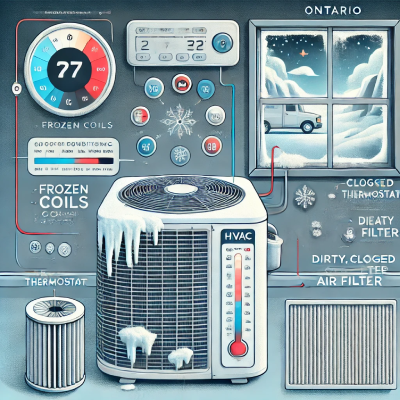
Common HVAC Issues in Ontario (Frozen Coils, Thermostat Issues, Clogged Filters)
HVAC systems in Ontario face several common problems, particularly during the extreme seasons of winter and summer:
- Frozen Coils: Frozen coils can occur in both heating and cooling systems. In air conditioning units, frozen evaporator coils are often caused by restricted airflow due to dirty filters or low refrigerant levels. In winter, heat pump coils can freeze due to external moisture and cold temperatures. Frozen coils reduce the system’s efficiency and, if left unaddressed, can cause the entire unit to fail.
- Thermostat Issues: Thermostats control the temperature settings in your home. If your thermostat malfunctions or is improperly calibrated, it can lead to inconsistent temperatures or the HVAC system failing to turn on altogether. Thermostat issues are common and can usually be resolved with a simple recalibration or by replacing outdated models with more advanced options like programmable or smart thermostats.
- Clogged Filters: Air filters play a crucial role in maintaining indoor air quality and ensuring proper airflow within the HVAC system. Over time, filters can become clogged with dust, dirt, and debris, reducing airflow and causing the system to work harder. Clogged filters not only decrease efficiency but can also lead to more significant issues such as frozen coils and overheating.
Importance of Quick Repairs to Avoid Further Damage and Higher Energy Bills
Delaying HVAC repairs can have serious consequences. When minor issues are left unaddressed, they can escalate into more severe and expensive problems. For example, a small refrigerant leak can lead to a complete system failure if not repaired promptly. Similarly, ignoring a malfunctioning thermostat can result in inconsistent temperatures and skyrocketing energy bills as the system struggles to maintain the desired temperature.
Quick repairs not only prevent further damage but also help keep your energy bills under control. A well-maintained HVAC system operates more efficiently, reducing energy consumption and extending the lifespan of the equipment. Regular repairs and timely maintenance can also improve indoor air quality, ensuring a healthier living environment.
How to Choose a Reliable HVAC Repair Service
Choosing the right HVAC repair service is essential for getting your system back up and running efficiently. Here are some factors to consider when selecting an HVAC repair service in Ontario:
- Experience and Certification: Ensure that the technicians are certified and have experience working with the type of HVAC system you have. NATE (North American Technician Excellence) certification is a widely recognized credential in the HVAC industry.
- Reputation and Reviews: Look for a company with positive reviews and a solid reputation in your area. Word-of-mouth recommendations from neighbors or online reviews can give you insight into the quality of service provided.
- Response Time: HVAC issues often require immediate attention, especially during extreme weather conditions. Choose a company that offers prompt service and is available for emergency repairs.
- Warranty and Guarantees: A reliable HVAC repair service should offer warranties on parts and labor. This ensures that any issues arising after the repair will be addressed without additional cost.
- Transparency in Pricing: Before hiring a repair service, make sure they provide clear pricing estimates and explain the scope of the work required. Avoid companies that are vague about costs or try to upsell unnecessary services.
HVAC Maintenance
Regular maintenance is one of the most effective ways to ensure the longevity and efficiency of your HVAC system. In Ontario, where weather extremes put additional strain on heating and cooling systems, regular HVAC maintenance is especially important. A well-maintained system is less likely to break down, operates more efficiently, and provides better indoor air quality.
Benefits of Regular HVAC Maintenance for System Longevity and Efficiency
The benefits of regular HVAC maintenance cannot be overstated. Here’s why it’s essential:
- Improved Efficiency: Regular maintenance ensures that your HVAC system operates at peak efficiency, reducing energy consumption and lowering your utility bills.
- Extended Lifespan: HVAC systems are expensive, and regular maintenance can help extend the life of your system by identifying and addressing minor issues before they become major problems.
- Fewer Repairs: Well-maintained systems are less likely to break down unexpectedly. Regular inspections allow technicians to catch potential problems early, reducing the likelihood of costly emergency repairs.
- Better Air Quality: HVAC maintenance includes cleaning and replacing air filters, which helps improve indoor air quality by removing dust, allergens, and pollutants.
- Consistent Comfort: A properly maintained HVAC system provides more consistent heating and cooling, ensuring that your home remains comfortable throughout the year.
Components of a Typical Maintenance Service
- Filter Changes: Filters should be changed regularly, typically every 1-3 months, depending on usage. Clean filters improve airflow and prevent dust and debris from clogging the system. Dirty filters not only reduce efficiency but also strain the system, leading to more frequent repairs.
- Duct Cleaning: Over time, dust, dirt, and other debris can accumulate in your HVAC ducts, reducing airflow and negatively affecting indoor air quality. Duct cleaning is an essential part of regular maintenance and helps ensure that your system is distributing clean air throughout your home.
- Thermostat Calibration: A well-calibrated thermostat ensures that your HVAC system maintains the desired temperature accurately. Incorrect thermostat settings can lead to uneven temperatures, increased energy consumption, and discomfort.
- Refrigerant Checks: Refrigerant is essential for cooling systems to function properly. Low refrigerant levels can indicate leaks, which not only reduce cooling efficiency but can also damage the system over time. Regular refrigerant checks help prevent these issues.
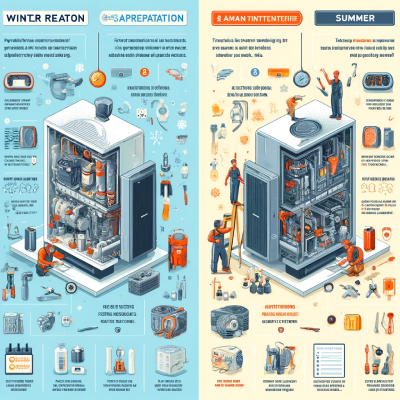
Importance of Seasonal HVAC Maintenance: Preparing for Winter and Summer
In Ontario, seasonal HVAC maintenance is particularly important due to the significant temperature differences between winter and summer.
- Winter Maintenance: Preparing your heating system for winter involves inspecting and cleaning the furnace, checking for gas leaks, and ensuring that the thermostat is calibrated correctly. You should also test carbon monoxide detectors to ensure they are working properly, as furnaces that burn natural gas can produce carbon monoxide if not ventilated properly.
- Summer Maintenance: Before the hot summer months, it’s essential to ensure that your air conditioning system is ready to handle the heat. Summer maintenance includes cleaning condenser coils, checking refrigerant levels, and ensuring that the air filters are clean.
Emergency HVAC Services
Emergencies can happen at any time, and HVAC systems are no exception. In Ontario’s extreme weather, a malfunctioning heating system in the winter or an air conditioner breakdown in the summer can quickly become an emergency.
What Qualifies as an HVAC Emergency (No Heat in Winter, No Cooling in Summer)
An HVAC emergency typically occurs when your heating or cooling system fails completely, leaving you without a way to maintain a comfortable indoor temperature. Some common emergency situations include:
- No Heat in Winter: When temperatures drop below freezing, losing heat in your home can become a safety concern. Prolonged exposure to cold temperatures can lead to health risks such as hypothermia and frozen pipes, which can cause water damage to your home.
- No Cooling in Summer: Ontario’s summers can be hot and humid, making air conditioning essential for comfort. A malfunctioning AC system during a heatwave can be dangerous, particularly for vulnerable individuals such as children, the elderly, and those with health conditions.
Benefits of Hiring a 24/7 HVAC Service
Hiring a 24/7 HVAC service provides peace of mind, knowing that help is available whenever you need it. Some benefits include:
- Quick Response Time: Emergency HVAC services are available around the clock, ensuring that technicians can address the issue promptly.
- Preventing Further Damage: Timely repairs can prevent further damage to your HVAC system, saving you from costly repairs or even a complete system replacement.
- Restoring Comfort: Fast repairs help restore your home’s comfort quickly, ensuring that you and your family are safe and comfortable during extreme weather conditions.
Steps Homeowners Can Take While Waiting for Emergency HVAC Assistance
While waiting for emergency HVAC services to arrive, homeowners can take several steps to mitigate discomfort and prevent further damage:
- For Heating Emergencies: If your furnace fails during the winter, close off unused rooms, dress in layers, and use space heaters if available. Ensure that any portable heating devices are used safely and do not leave them unattended.
- For Cooling Emergencies: During a summer AC failure, close blinds and curtains to block out sunlight and prevent overheating. Use fans to circulate air and keep windows open during cooler parts of the day.
Energy Efficiency and HVAC Upgrades
In Ontario, where extreme weather conditions are common, maintaining a comfortable indoor environment year-round is essential. However, heating and cooling costs can quickly add up, especially with older, inefficient HVAC systems. Homeowners and businesses increasingly prioritize energy efficiency as a way to reduce utility bills, improve indoor air quality, and decrease their environmental footprint. Upgrading to modern, energy-efficient HVAC systems offers substantial long-term savings, better performance, and access to provincial incentives.
How Energy-Efficient HVAC Systems Can Reduce Utility Bills
Energy-efficient HVAC systems are designed to provide optimal heating, cooling, and ventilation with minimal energy consumption. Traditional systems tend to waste energy, either by running constantly or by not distributing conditioned air effectively. Energy-efficient HVAC systems, such as those with ENERGY STAR ratings, use advanced technologies to minimize this energy waste.
Key Benefits of Energy-Efficient HVAC Systems:
- Lower Energy Consumption: Energy-efficient HVAC systems use less electricity, gas, or oil to maintain comfortable temperatures. They achieve this by employing features such as variable speed motors, smart thermostats, and advanced filtration systems that optimize system performance based on the actual demands of your space.
- Improved Temperature Regulation: Traditional systems may overheat or overcool spaces due to improper load sizing or poor thermostat control. Energy-efficient systems, on the other hand, maintain a consistent temperature more effectively, reducing the need for constant adjustments that waste energy.
- Reduced Operating Costs: With energy-efficient systems, you’ll experience significant savings on monthly utility bills. These systems are designed to operate more efficiently, which translates to lower electricity and fuel usage over time.
- Lower Maintenance Costs: Many energy-efficient HVAC systems are built with high-quality components that last longer than older models. They are also designed to work smarter, not harder, which reduces wear and tear on system components, leading to fewer repairs and lower maintenance costs over time.
- Environmental Benefits: Energy-efficient HVAC systems reduce greenhouse gas emissions and reliance on fossil fuels. Switching to a high-efficiency system helps contribute to a more sustainable, eco-friendly lifestyle, something more homeowners and businesses are striving for in Ontario.
Ontario’s Energy-Efficiency Incentives for HVAC Upgrades
The Government of Ontario offers a range of energy-efficiency programs and rebates to encourage homeowners and businesses to upgrade to more efficient heating, cooling, and ventilation systems. These incentives not only help offset the upfront costs of HVAC upgrades but also promote the adoption of environmentally friendly technologies that reduce energy consumption across the province.
Popular Energy-Efficiency Programs in Ontario:
- GreenON Rebates: While the GreenON program has ended, it was one of the most prominent government-backed initiatives designed to help homeowners reduce energy usage. The program offered rebates for various energy-efficient upgrades, including HVAC systems. Homeowners who participated in the program received incentives for upgrading to high-efficiency furnaces, air conditioners, heat pumps, and other HVAC equipment.
- Save on Energy: Save on Energy is an ongoing program run by the Independent Electricity System Operator (IESO) in Ontario, offering rebates and incentives for energy-efficient home upgrades. This program provides various rebates for high-efficiency heating and cooling systems, such as air conditioners, furnaces, and heat pumps, making it easier for residents to invest in HVAC upgrades that reduce their overall energy consumption.
- Enbridge Home Efficiency Rebate: Enbridge offers rebates to homeowners who improve their home’s energy efficiency through insulation upgrades, furnace or boiler upgrades, and other energy-saving measures. Enbridge customers can receive up to $5,000 in rebates, including up to $1,000 for upgrading to high-efficiency furnaces and other HVAC equipment.
- Canada Greener Homes Grant: This national program offers up to $5,000 in grants to help homeowners make energy-efficient retrofits, including HVAC upgrades. Ontario homeowners can use this grant to upgrade their heating and cooling systems, improve insulation, and invest in renewable energy solutions like heat pumps.
These programs are designed to make energy-efficient HVAC systems more accessible to Ontario residents, reducing both the financial burden of the initial installation and long-term operational costs.
When to Upgrade Your HVAC System
Knowing when to upgrade your HVAC system can make all the difference in comfort, energy savings, and overall system performance. While many homeowners wait until their system breaks down completely, upgrading before a major failure can save money and headaches. Here are some key signs that it may be time to replace your HVAC system.
Signs That Your System Is Outdated
- Age of the System: Most HVAC systems last between 10 to 15 years. If your system is older than this, it’s likely outdated and not running as efficiently as it could be. Even if it still functions, older systems consume more energy and cost more to operate compared to newer, energy-efficient models.
- Rising Energy Bills: If you’ve noticed an increase in your energy bills without a significant change in usage patterns, it could be a sign that your HVAC system is losing efficiency. Older systems must work harder to maintain the desired temperature, leading to higher utility costs.
- Frequent Repairs: If your HVAC system needs frequent repairs or if the cost of fixing it is approaching the cost of a new system, it’s time to consider an upgrade. New systems require less maintenance, reducing both repair costs and downtime.
- Uneven Heating or Cooling: An inefficient HVAC system may struggle to maintain consistent temperatures throughout your home. If you notice that some rooms are too hot or too cold, or if the system is constantly cycling on and off, these are signs that it’s time for an upgrade.
- Noisy Operation: If your HVAC system is making unusual noises—such as banging, rattling, or squealing—it may be due to worn-out components. While some issues can be repaired, a noisy system could be a sign that the entire unit is nearing the end of its lifespan.
Benefits of Switching to an ENERGY STAR-Rated System
When it’s time to upgrade, choosing an ENERGY STAR-rated HVAC system offers several advantages. ENERGY STAR systems are independently certified to use less energy, save money, and help protect the environment. These systems must meet strict energy-efficiency guidelines set by the U.S. Environmental Protection Agency (EPA) and Natural Resources Canada, ensuring superior performance.
Top Benefits of ENERGY STAR-Rated Systems:
- Significant Energy Savings: ENERGY STAR systems are designed to use up to 20% less energy than standard HVAC models. These energy savings translate directly to lower utility bills, helping to recoup the cost of the system over time.
- Advanced Technology: ENERGY STAR systems often come with the latest HVAC technology, such as variable-speed motors, two-stage compressors, and smart thermostats. These features allow for better temperature control, reduced energy consumption, and enhanced comfort.
- Environmental Benefits: By using less energy, ENERGY STAR-rated systems help reduce greenhouse gas emissions and the overall demand for fossil fuels. Switching to an ENERGY STAR system is a tangible way to reduce your carbon footprint and contribute to a more sustainable future.
- Quieter Operation: Many ENERGY STAR HVAC systems are designed to operate more quietly than older models, making them less disruptive to your daily routine. Quieter systems are especially beneficial in residential settings where excessive noise can be an issue.
- Improved Indoor Air Quality: ENERGY STAR systems often include advanced filtration features that help remove dust, pollen, and other airborne contaminants. Improved indoor air quality contributes to a healthier living environment, particularly for individuals with allergies or respiratory conditions.
Long-Term Savings from Investing in Energy-Efficient Units
Upgrading to an energy-efficient HVAC system is not just an investment in your home’s comfort; it’s also a smart financial decision. While the upfront cost of purchasing and installing a high-efficiency system may be higher than standard models, the long-term savings can be substantial. Here’s why investing in an energy-efficient HVAC system pays off in the long run:
- Lower Utility Bills: The most immediate benefit of an energy-efficient HVAC system is the reduction in monthly energy bills. Over the lifespan of the system, these savings can add up to thousands of dollars, significantly offsetting the initial installation cost.
- Increased Home Value: Homebuyers are increasingly looking for energy-efficient homes with modern HVAC systems. Investing in an energy-efficient unit can boost the resale value of your property and make it more appealing to potential buyers.
- Extended Lifespan: High-efficiency HVAC systems are built to last longer than standard systems. They experience less wear and tear due to features like variable speed motors, which reduce strain on the system by running at lower speeds when full power isn’t necessary.
- Rebates and Incentives: As mentioned earlier, Ontario offers several rebates and incentives for upgrading to energy-efficient HVAC systems. These programs can help reduce the upfront cost of installation, making it more affordable to invest in high-efficiency equipment.
- Fewer Repairs and Lower Maintenance Costs: Energy-efficient systems require less maintenance and fewer repairs than older, less efficient units. Advanced features like smart diagnostics and self-regulating components help prevent breakdowns and ensure the system runs smoothly for years to come.
- Improved Comfort: Energy-efficient HVAC systems are better at maintaining consistent temperatures, reducing humidity, and improving overall indoor comfort. This creates a more enjoyable living environment and ensures that your home stays comfortable throughout Ontario’s changing seasons.
Conclusion
In Ontario, where seasonal temperature extremes are common, having a reliable heating and cooling system is essential for maintaining indoor comfort year-round. Understanding the different types of HVAC systems and the range of services offered by top companies is crucial for making informed decisions about installation, maintenance, and repairs. From energy-efficient solutions to expert guidance on system upgrades, the right HVAC service provider can enhance the longevity and performance of your heating and cooling systems while reducing energy costs.
Resources
Energy-Efficient HVAC Maintenance Tips
Energy Star – Guide to Energy-Efficient Heating & Cooling
Government of Canada – Home Heating & Cooling Systems
ASHRAE – Basics of HVAC Systems
Natural Resources Canada – Heating and Cooling with a Heat Pump
Ontario.ca – Energy Efficiency in Ontario
HVAC.com – Guide to HVAC Systems
American Lung Association – Indoor Air Quality
Carrier – How HVAC Systems Work
Department of Energy – Thermostat Settings
Trane – Guide to Selecting HVAC Systems
Energy Star – Energy-Efficient HVAC Systems
Ontario.ca – Energy Efficiency in Ontario Homes Enbridge – Home Efficiency Rebate
